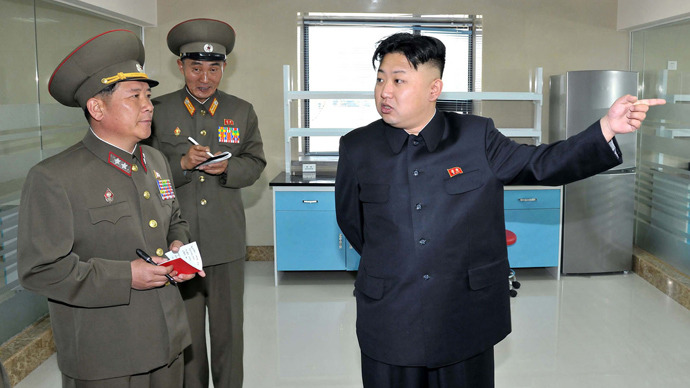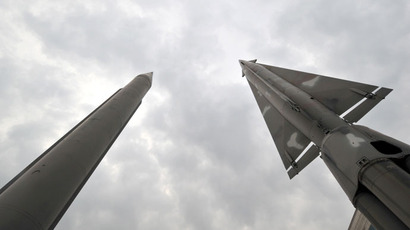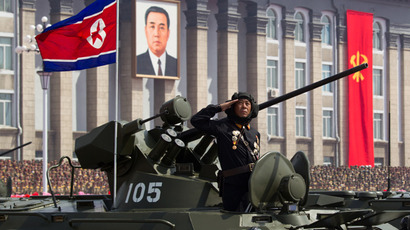North Korea removes missiles from launch sites

In a sudden de-escalation of tension on the Korean Peninsula, Pyongyang has removed two of its ballistic missile units from their launching positions, US officials confirmed.
Two Musudan missiles, capable of hitting targets 2,500 miles away, were withdrawn from a launch site in the eastern part of the country and moved to a storage facility, several US officials who chose to remain anonymous told the media.
The US, which considers Korean missile program as a threat to its national security in parts of the Pacific Ocean, has confirmed that the weapons have now been relocated, a defense official told AFP.
The news comes soon after Seoul and Washington kicked-off on Monday a five-day anti-submarine drill in the Yellow Sea with the presence of nuclear-powered forces, military officials told Yonhap news agency.
The US mobilized a nuclear-powered Los Angeles-class submarine, Aegis destroyers and maritime surveillance aircrafts to join South Korean destroyers, submarines and maritime aircrafts. A 7,000-ton Nimitz-class nuclear powered super carrier is expected to join the training.
The latest set of drills follow the completion of the two-month-long Foal Eagle exercise, which caused the recent escalation of tension between the North and South, as Pyongyang repeatedly threatened to unleash its missiles on the South and its allies.
North Korea warned against the anti-submarine exercises on Saturday, calling for an end to “hostile acts and military provocations” while threatening closure of the Kaesong complex, the only joint industrial zone and the only communication channel between two Koreas.
The Southwestern Front Command of the Korean People's Army stated its readiness to respond if any projectiles fall on its territory during the manoeuvres. If this happens Pyongyang has warned that it could strike five South Korean islands in the disputed border area.

Until last month, the industrial zone employed more than 53,000 North Korean workers and hundreds of South Korean managers. The factory gradually began halting operations amid the escalations of hostility followed by the withdrawal of North Koreans working for the 123 South Korean firms in Kaesong park.
South Korean officials criticized their neighbor on Monday for linking defense maneuvers to joint projects.
“It is inappropriate that the North is demanding the cancellation of South Korea-US joint drills by linking it with the Kaesong Industrial Complex,” S. Korean defense ministry spokesman Kim Min-seok said in a briefing.
“As long as the North maintains its hostile stance, the joint drills will continue,” Kim said.
The developments come as South Korean President Park Geun-hye began a six-day official trip to the US on Sunday, where he plans to focus on the North Korean missile program.
There are concerns that US provocation with the ongoing show of force on the peninsula will push the North to strike, such as the two attacks on an island in 2010 which killed 50 South Koreans.
The recent joint military exercises have seen the US display its air superiority with the display of nuclear capable B-52 and B-2 bombers. It is also increasing its military presence in the region by sending F-22 stealth fighter jets to South Korea from Japan.
Washington has also announced the deployment of a missile defense system to be sent to Guam to defend against ballistic missile launches on its interests in the Pacific.
Figures released by the US Department of Defense in March show that over 37,000 US soldiers are stationed on the Korean Peninsula, which is some 9,000 more personal than allowed by the 2008 agreement.
Last month, the United Stated announcement it was abandoning a key part of its Eastern European missile defense plan shifting the focus to perceived threats from North Korea.
The restructuring of the program will see $1 billion shifted to add some 14 new interceptors to the 26 existing ones in Alaska designed to counter potential North Korean missiles.
On a cyber-front, hackers allegedly broken into at least two of North Korea's government-run online sites; while on the weapons site, US chemical weapons experts returned to South Korea in early April for the first time in eight years.
The American navy has also moved a sea-based X-band radar platform closer to North Korea from Hawaii to track possible missile launches.
In addition, nuclear-powered US warships routinely dock in South Korea as part of joint exercises aimed at enhancing naval cooperation between two states.
All of the US military build-up has been accompanied by loaded anti-Pyongyang rhetoric from Washington.
On Tuesday, President Obama made it clear that that North Korea cannot result to nuclear provocations to create international crises.
“The days when North Korea could create a crisis and elicit concessions, those days are over,” Obama said.
Last month, US Defense Secretary, Chuck Hagel stated that “North Korea has been with its bellicose rhetoric, with its actions, skating very close to a dangerous line.”
Hagel also stressed “that country is unpredictable, if that is the reality that we're dealing with, and it is, you prepare for every contingency.”
Since the beginning of the two-month joint military exercise between Seoul and Washington in February, the North has issued a number of alarming threats against the South and the United States, including a threat to conduct another nuclear test and a ballistic missile launch.
The escalation of threats from the North also followed introduction of stricter UN sanctions against Pyongyang following the completion of its third underground nuclear test in February.














